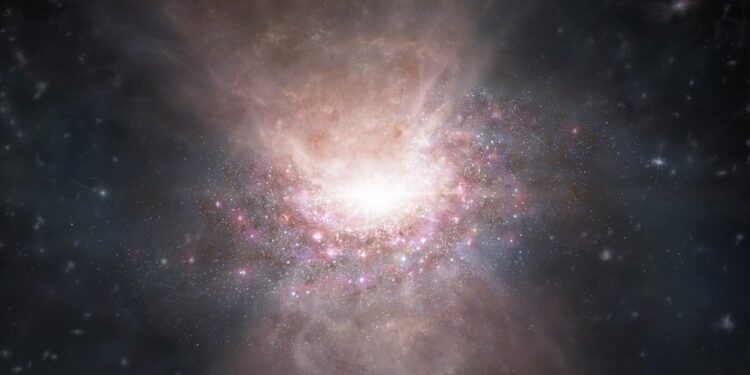Artist’s impression of a molecular gas outflow from quasar J2054-0005. Credit: ALMA (ESO/NAOJ/NRAO)
Theoretical predictions were confirmed by the discovery of a flow of molecular gas from a quasar when the universe was less than a billion years old.
A quasar is a compact region powered by a supermassive black hole located at the center of a massive galaxy. They are extremely luminous, with a point-like appearance similar to stars, and are extremely distant from Earth. Because of their distance and brightness, they provide insight into conditions in the early universe, when it was less than a billion years old.
A team of researchers led by Assistant Professor Dragan Salak of Hokkaido University, Assistant Professor Takuya Hashimoto of Tsukuba University and Professor Akio Inoue of Waseda University discovered the first evidence of the suppression of Star formation caused by a flow of molecular gas in a quasar host galaxy in the early universe. Their results, based on observations they made using the Atacama Large Millimeter/submillimeter Array (ALMA) in Chile, were published in The Astrophysics Journal.
Molecular gas is essential for star formation. As the primary fuel for star formation, the ubiquity and high concentrations of molecular gases in a galaxy would cause large numbers of stars to form. By ejecting this gas into intergalactic space faster than it could be consumed by star formation, molecular flows effectively suppress star formation in galaxies that host quasars.
A group of 12m ALMA antennas observing the night sky. The observations in this study were carried out using 12 m antennas. Credit: Photo: ESO/Y. Beletsky
“Theoretical work suggests that molecular gas outflows play an important role in the formation and evolution of galaxies from an early age, because they can regulate star formation,” says Salak. “Quasars are particularly energetic sources, so we expected them to be capable of generating powerful outflows.”
The quasar observed by the researchers, J2054-0005, has a very high redshift: it and the Earth are apparently moving away from each other very quickly.
“J2054-0005 is one of the brightest quasars in the distant universe, so we decided to target this object as an excellent candidate for studying powerful outflows,” says Hashimoto.
The researchers used ALMA to observe the outflow of molecular gas from the quasar. As the world’s only telescope with the sensitivity and frequency coverage needed to detect molecular gas outflows in the early universe, ALMA played a key role in this study.
Speaking about the method used in the study, Salak said: “The outgoing molecular gas (OH) was discovered through absorption. This means that we did not observe microwave radiation coming directly from the OH molecules; instead, we observed radiation coming from the bright quasar. – and absorption means that the OH molecules have absorbed part of the quasar’s radiation. It was therefore like revealing the presence of a gas by seeing the “shadow” that it projected in front of the light source.
The molecular gas leaving the quasar includes hydroxyl (OH) (top). Due to the movement of the molecular gas toward the observer, the OH peak in the absorption spectrum (bottom, dotted blue line) appears at a shorter wavelength (solid blue line), a phenomenon known as Doppler effect. Credit: ALMA (ESO/NAOJ/NRAO) modified from Dragan Salak, et al. The Astrophysics Journal. February 1, 2024
The results of this study provide the first solid evidence for the existence of powerful molecular gas flows originating from quasar host galaxies and have an impact on the evolution of galaxies in the early cosmic era.
“Molecular gas is a very important constituent of galaxies because it provides the fuel for star formation,” concludes Salak. “Our findings show that quasars are capable of suppressing star formation in their host galaxies by ejecting molecular gas into intergalactic space.”
More information:
Molecular output in quasar J2054-0005 from the reionization epoch revealed by OH 119 μm observations, The Astrophysics Journal (2024). DOI: 10.3847/1538-4357/ad0df5
Provided by Hokkaido University
Quote: ALMA spots the shadow of a molecular flow from a quasar when the universe was less than a billion years old (February 1, 2024) retrieved on February 1, 2024 from
This document is subject to copyright. Except for fair use for private study or research purposes, no part may be reproduced without written permission. The content is provided for information only.



